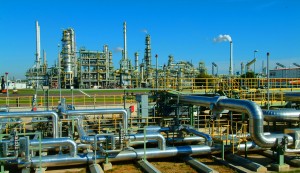 Both West Texas Intermediate and Brent crude extended gains on Tuesday as better-than-expected third-quarter economic growth in the US fanned positive sentiment about oil demand in the worlds top consumer. Gains were capped as OPEC members reaffirmed their commitment not to cede market share. Natural gas advanced amid forecasts for a cold end to December.
Both West Texas Intermediate and Brent crude extended gains on Tuesday as better-than-expected third-quarter economic growth in the US fanned positive sentiment about oil demand in the worlds top consumer. Gains were capped as OPEC members reaffirmed their commitment not to cede market share. Natural gas advanced amid forecasts for a cold end to December.
US crude for delivery in February rose 2.39% to $56.58 per barrel by 13:38 GMT, having shifted in a daily range of $56.85-$55.31 a barrel. The contract fell 3.27% on Monday to $55.26 after it surged 5.10% the previous session.
Meanwhile on the ICE, Brent for settlement in the same month was up 1.90% at $61.25 per barrel. Prices ranged between $61.49 and $59.84 during the day. The European benchmark crude fell 2.07% on Monday to $60.11, settling at a premium of $4.85 to its American counterpart. The gap narrowed to $4.67 on Tuesday.
The Commerce Department’s Bureau of Economic Analysis reported that economic growth in the US accelerated to 5.0% in the the third quarter, the fastest since Q3 2003, as US consumers and businesses spent more than initially estimated. This compared to analysts projections of 4.3% and a preliminary estimate of 3.9%.
However, durable goods orders unexpectedly dropped in November as the cooling global economy induced less or little changed demand for computers, metals and electrical equipment. Orders for goods meant to last more than three years fell by 0.7% in November, confounding projections for a 3.0% jump. A core measure slid 0.4%, rebutting forecasts for a 1.1% gain, while durable goods orders ex defense contracted 0.1% as opposed to an expected 1.6% jump.
Data later in the day will likely show that personal income rose by 0.5% in November on a monthly basis, compared to 0.2% in October. If confirmed, this would match expectations for a 0.5% jump in personal spending, which also grew by 0.2% the preceding month.
In other reports, December consumer sentiment likely remained high but an inch lower, with the corresponding Thomson Reuters/University of Michigan index projected at 93.1 from 93.8 in November, while new home sales probably increased.
OPEC comments
However, OPEC’s determination to maintain its current production level and not cede market share kept upside movement capped. Saudi Arabian Oil Minister Ali Al-Naimi told the Middle East Economic Survey on Monday that the kingdom doesnt plan to scale back production regardless of the prices reached. “Whether it goes down to $20, $40, $50, $60, it is irrelevant,” he was cited.
On Sunday, Al-Naimi said that the global supply glut that recently drove oil prices to the lowest in 5-1/2 years was created by the lack of cooperation from non-OPEC producers. The group will probably refrain from cutting output, even if non-member producers offer to pump less, Al-Naimi said, and expressed confidence that oil will rebound as reviving global economic growth will spur demand.
In the latest sign of group members adopting Saudi Arabia’s view, Iraqi Oil Minister Adel Abdul Mahdi said that Iraq plans to raise production to 4 million barrels per day next year and that the group’s November 27 decision to maintain output was part of an effort to retain market share. Prices have fallen some 20% since then.
This comes at a time of ever-growing US crude output, with the Energy Information Administration having reported that US producers pumped 9.137 million barrels of crude per day in the week ended December 12th, the highest on weekly data started in January 1983.
UAE Energy Minister Suhail Al Mazrouei said on Sunday that “irresponsible” production from outside OPEC is behind the fall in prices. “We call on all other producers to stop the increase” he said.
According to Mohammed Al Sada, Qatar’s energy minister, the market suffers from an excess supply of 2 million barrels per day. Oil prices have fallen more than 40% since a June peak amid concerns that a weaker global economy would not induce enough demand to absorb rising supplies.
Bank of America Merrill Lynch said in a research note, cited by CNBC: “Brent could drop below $60 per barrel over the next six months, and WTI could fall to $50, as global oil inventories build sharply from here. The faster the oil price drop, the larger the damage to the global oil industry.”
Force majeure
Meanwhile in Libya, the Petroleum Facilities Guard, the force that defends Libyas eastern oil ports, managed to push back Islamist militias which attempted to capture the terminals under orders by the Islamist-backed, self-proclaimed government of Omar al-Hassi.
Ali al-Hasy, a spokesman of the Petroleum Facilities Guard, said, cited by Bloomberg: “We pushed them back and it’s we who are now attacking them. The oil ports are safe and they suffered no damage. All the fighting took place well outside the ports.”
Output in Libya was reported to have fallen below domestic demand. The state-run National Oil Corp. declared on December 13th force majeure in Libyas biggest and third-biggest oil ports – Es Sider and Ras Lanuf. The internationally-recognized government of Abdullah al-Thinni sought refuge in the countrys East after Omar al-Hassi formed a rival government in Tripoli five months ago, backed by Islamist militias.
Natural gas
Natural gas gained on Tuesday to end three consecutive days of declines as forecasting agencies projected a colder end to the year.
On the New York Mercantile Exchange, natural gas for delivery in January gained 1.53% to $3.192 per million British thermal units by 13:38 GMT, having shifted in a daily range between $3.234 and $3.142 per mBtu. The energy source plunged 9.24% to $3.144 on Monday, but not before it reached $3.124, its lowest since January 2013.
According to NatGasWeather.com, US natural gas demand will be moderate compared to normal over the next seven days.
The Midwest will experience a period of rain and snow brought by a weather system moving through the region. Another weather system will form over the Southeast and later flow north to deliver heavy rains and strong winds to the East Coast. It is expected to leave behind only small accumulations of snow over the East Coast, with greater potential over the Great Lakes and interior Northeast.
A new weather system will crash into the Northwest early next week, NatGasWeather.com reported, marking the beginning of a series of strong cold winter blasts to the northern US.
Around New Year’s Eve another weather system of the series will also hit the central US, bringing rain, snow and sub-freezing temperatures. However, it is still unknown how far into the US these conditions will push, but it is certain that colder air will be arriving.
Temperatures over the southern US are expected to fluctuate as mild conditions arrive into the region, followed by colder weather systems.
Supplies
The Energy Information Administration said reported last week that US natural gas stockpiles fell by 64 billion cubic feet (bcf) in the week ended December 12th, exceeding analysts’ projections for a withdrawal of 57-63 bcf but also falling well behind the five-year average drop of 157 bcf.
Total gas held in US storage hubs amounted to 3.295 trillion cubic feet as of December 12th, scoring a 0.2% surplus to last year’s level of 3.289 trillion during the comparable period, but also narrowing its deficit to the five-year average of 3.553 trillion to 7.3%.
Due to last week’s mild weather, this week’s supplies withdrawal is expected to again be much thinner than the five-year average, with projections pointing to a 60-bcf draw, compared to the average of -138 bcf. The deficit to the five-year average is expected to further shrink next week, with early estimates hinting of another smaller-than-average inventory decline due to this week’s overall mild weather.





